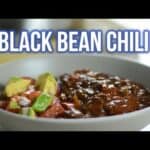Without beans, chili isn’t chili, right? Wrong! It is absolutely possible to make an equally delicious, nutritious, and wholesome chili without beans – guaranteed to please the entire family. Chili can be made with a variety of substitutes, depending on why beans are omitted in the first place.
Substitutes for Beans in Chili
Chili recipes will differ from one another, so you can put your own creative spin on them. These bean substitutes give you the opportunity to experiment with what combinations you like best.
Pork/Beef
Because meat is high in protein, low in carbs, and very easy to cook, it is a good substitute for beans. Ground beef is an essential part of chili, according to some people. It is likely that those who eat meat would do so anyway, whether they included beans or not.
No matter how you look at it, beans and meat are often the building blocks of any high-protein meal. However, there is a massive wave of people moving to a plant-based diet, so the rest of the substitutions on this list will be suitable for that group.
Lentils/ Split Peas/ Edamame
You could choose any one of these three legumes as a substitute for beans that cooks much faster. Add ¾ cups of lentils or split peas to a big pot of chili, and let them cook there, absorbing the excess liquid and spices.
Add them to the chili at the end after they have been cooked ahead of time. Once your chili is done cooking, add a frozen bag of edamame to it.
The ratios of these legumes to beans are similar, so this option is not recommended if you are looking to reduce your carb intake. Although they may be slightly easier to digest, phytic acid is still present.
Texturized Vegetable Protein (TVP)
The TVP is made of soy flour. It is often used as a substitute for meat because it is inexpensive and high in fiber and protein. It is a popular choice when looking for a meat-free bean substitute in chili since it easily fools people into thinking they are eating ground beef.
As it is unfermented, it contains the antinutrient phytate (also known as phytic acid), the same ingredient that makes beans hard to digest. Therefore, if you can’t digest beans, you might not be able to digest TVP.
Tofu
Similar to tofu, TVP does not possess its own taste. As a result, they are highly versatile, absorbing the flavor of whatever is being cooked. Tofu is a soymilk derivative, so it contains fewer carbs than whole soybeans or other beans.
Like TVP, tofu is also an unfermented soy product that contains the antinutrient phytate, making it difficult for some people to digest. To see how your body reacts to certain foods, you will need to experiment with all the suggestions made here.
As tofu is the crop most commonly genetically modified, some people avoid it entirely. Other people prize it for its high protein content.
Tempeh
Tempeh, a less commonly known, healthier alternative to tofu, is also easier to digest. Tofu is made from only one part of the soybean, whereas tempeh is made from fermented whole soybeans pressed together.
Tempeh is easier to digest than tofu, but it contains more carbohydrates because it is made up of the whole soybean. Break up the tempeh into pieces and stir it into your chili towards the end of the cooking process.
Don’t be nervous about cooking tempeh for the first time if you’ve never heard of it. Tempeh is easy to prepare, and you are likely to enjoy its texture and flavor.
Gluten-free Grains
People who are gluten intolerant can enjoy gluten-free grains since beans are also gluten-free. Grains are also often high in protein, which is a popular trait of plant-based substitutes. Phytic acid is also found in grains, though less than in legumes.
Consequently, they may be a suitable alternative to beans, even for those who have difficulty digesting beans. Others may still have difficulty digesting grains. It will be trial and error, and everyone’s tolerance will be different.
It’s easy to include grains in chili if you want to give it a try. Once your chili has finished cooking, add one cup of cooked grain. For additional flavor, you can cook your grain in your chili.
After you have sauteed the vegetables, add ½ cups of dried grain to the chili and at least one more cup of water. At least 15 minutes should be allowed for the grain to simmer. Taste it to see if it is done cooking. If not, add more water and keep tasting until the texture is right.
Regardless, if you still prefer to use beans in your chili, we have some recommendations if you are looking for the best one.
Was this helpful?
Hi there! I’m a food enthusiast and journalist, and I have a real passion for food that goes beyond the kitchen. I love my dream job and I’m lucky enough to be able to share my knowledge with readers of several large media outlets. My specialty is writing engaging food-related content, and I take pride in being able to connect with my audience. I’m known for my creativity in the kitchen, and I’m confident that I can be the perfect guide for anyone looking to take their culinary journey to the next level.









